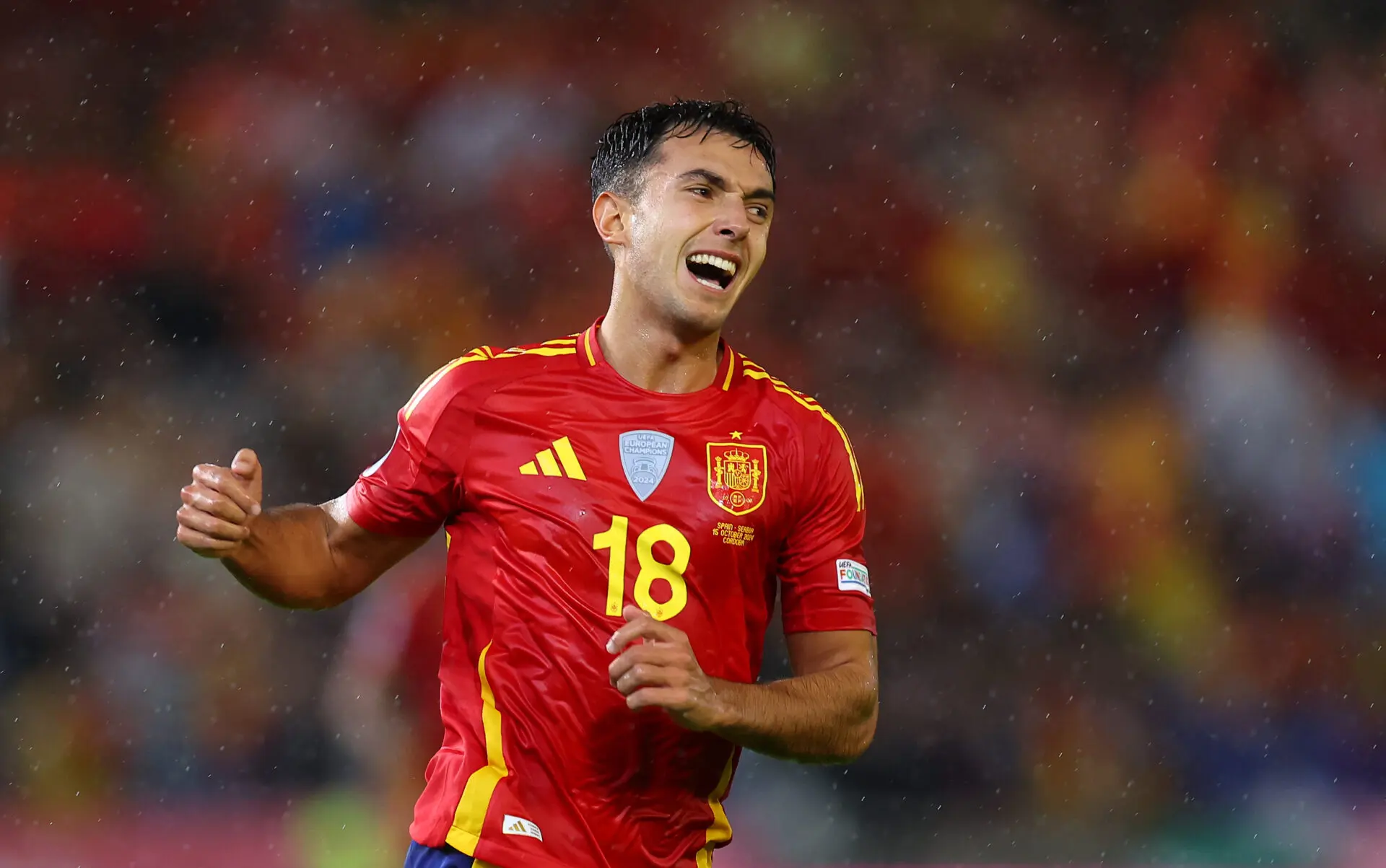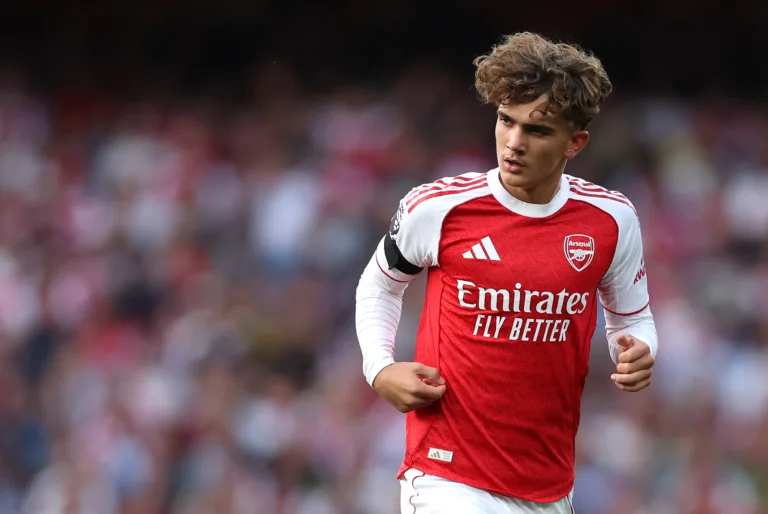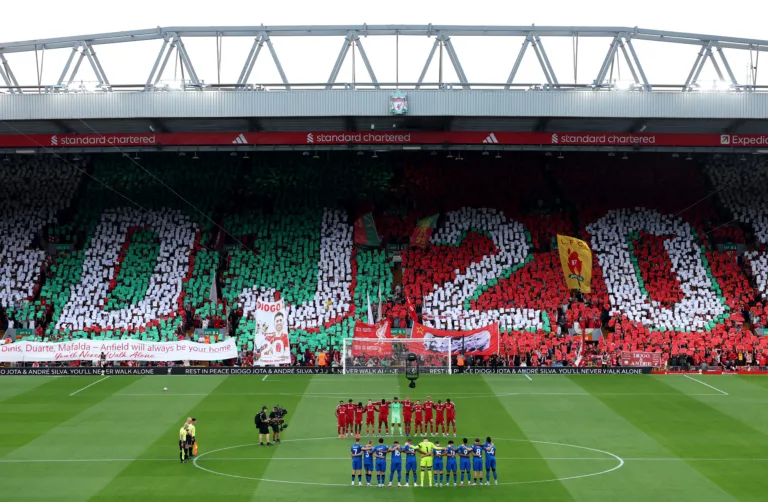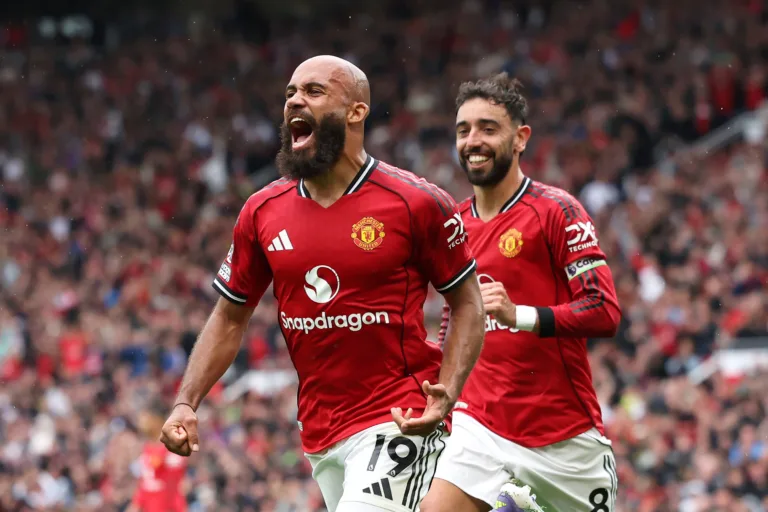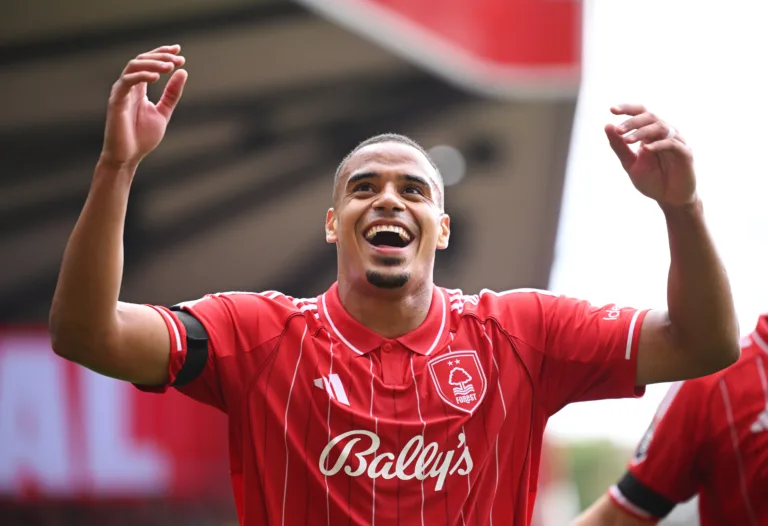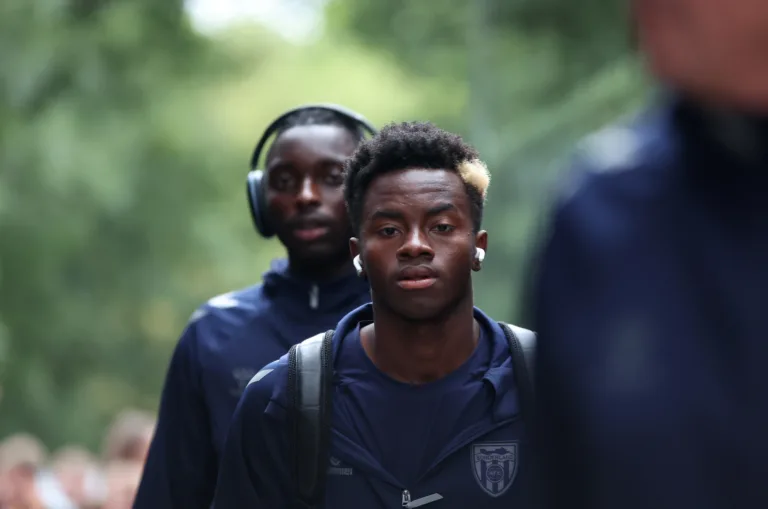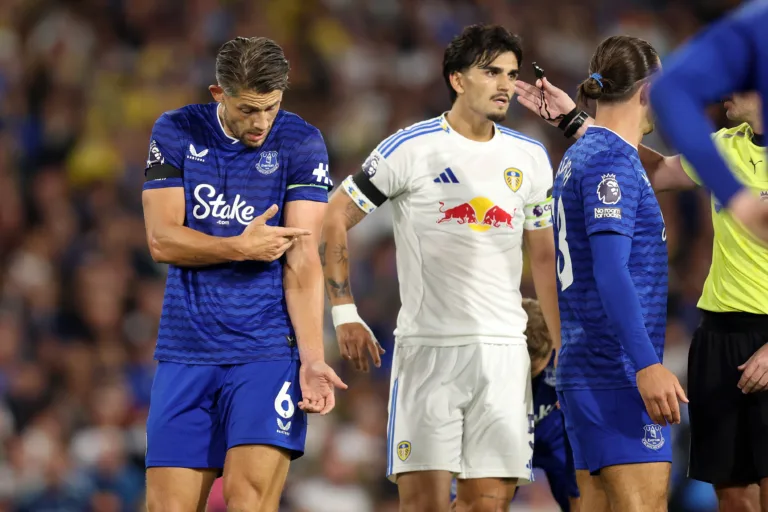Martín Zubimendi: Football’s Most Sought After Number Six
Martín Zubimendi was one of the main talking points last summer for different reasons. From his 45-minute cameo in the Euro final to his decision to reject Arne Slot’s Liverpool and stay with Real Sociedad in the Spanish mountains, the 25-year-old midfielder was loved yet hated by many.
And while the “Txuri-Urdin” have struggled this season to adapt after losing key players like Mikel Merino and Robin Le Normand, Zubimendi has actually taken his game to the next level, becoming a crucial player for the Spain national team and a potential target for a Rodri-less Manchester City.
This article will break down Zubimendi’s performances in the 2023-24 season, explain why he’s now one of the most in-demand number-sixes in Europe, and highlight how the Spaniard is further improving his game this season.
In Possession:
Understanding Real Sociedad’s System:
To really understand what Zubimendi brings to the table, we need to look at how he was used at Real Sociedad last season. First, this plot chart clearly shows that Real Sociedad is a possession-based team. They ranked among the top sides in Europe’s top five leagues in possession percentage and positional attacks per 90 minutes.
They not only dominate possession for long stretches but also use it to methodically build their attacks.
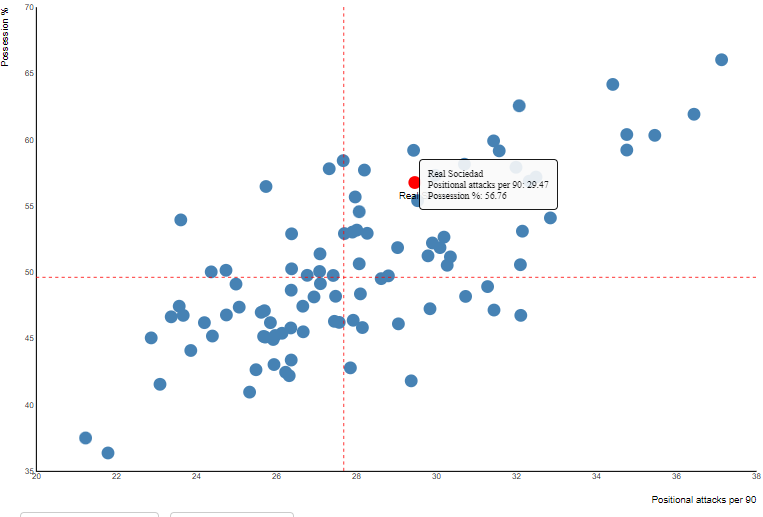
A Metronome Within the Chaos
To pull this possession dominance and playstyle off consistently, a team needs a midfielder who can act as a metronome, keeping the play flowing and always being available as a passing option to help maintain possession. This is exactly where Martín Zubimendi excels.
Real Sociedad often used a 4-2 build-up shape, with the back four positioned very flat to stretch the opposition’s press as much as possible, opening up more space in central areas. In the double pivot, Zubimendi was typically paired with Mikel Merino or sometimes Arsen Zakharyan.
However, it was almost always Zubimendi who played as the deepest of the two, anchoring the midfield.

At times, Zubimendi operates as the lone number six when Sociedad is in possession, sitting just in front of the four-man backline while the other midfielders push further up the pitch.
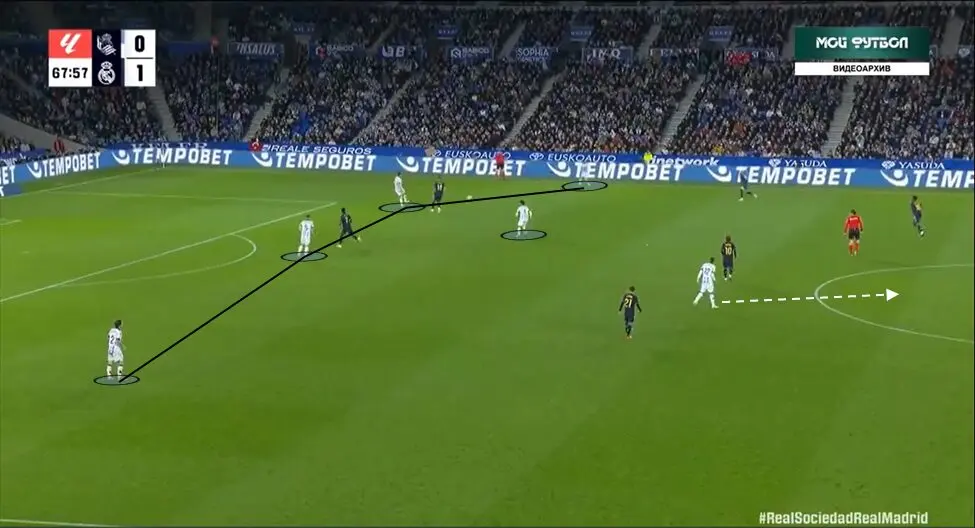
So, what qualities make Zubimendi so effective in this delicate role? Let’s start with the most obvious: his passing. At first glance, checking his Fbref profile from last season, one might think he’s just an average player. He didn’t rank in the high percentiles for passes attempted or even completion rate. But this can be misleading, and it shows why stats alone aren’t enough to judge a player’s true quality.
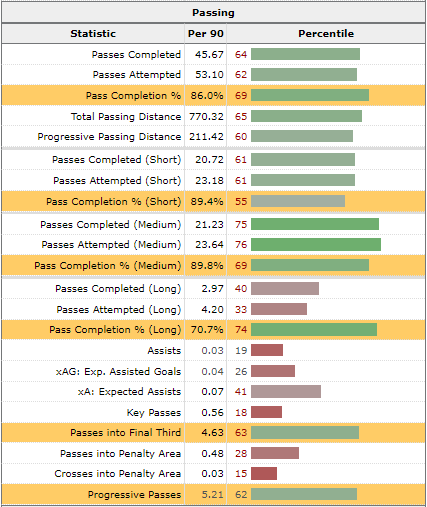
On the other hand, Zubimendi leads all Real Sociedad midfielders in xGBuildup with a score of 7.47. This metric measures the total expected goals of every possession a player was involved in, excluding key passes and shots. It highlights just how crucial he is to Sociedad’s possession-based approach, acting as the vital link in midfield that helps generate attacks.
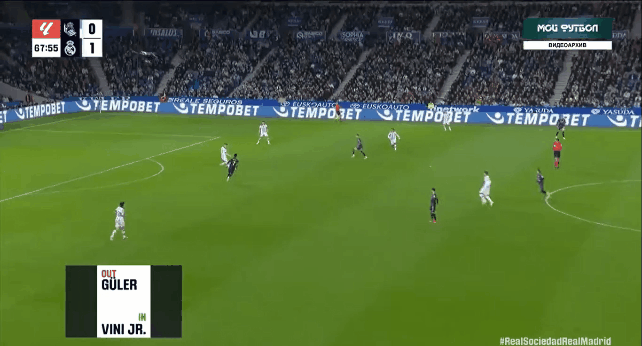
Zubimendi’s passing isn’t about flashy, highlight-reel moments—it’s about timing, precision, and weight. He keeps the game flowing by ensuring his teammates receive the ball in the best possible positions, often on their stronger foot. His brilliance lies in the simplicity of his play: he rarely takes more than two touches before moving the ball, either back to where he got it or to another teammate in space.
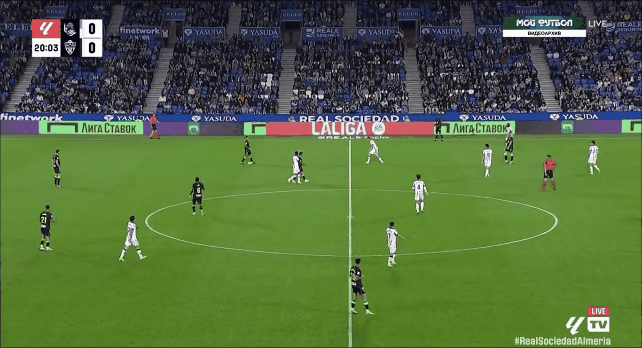
Another crucial aspect of Zubimendi’s game is how comfortable he is at receiving the ball with his back to the play. No matter how much pressure the opposition applies, it’s rare to catch him off guard. He’s always scanning his surroundings, fully aware of whether he has the time and space to take the ball and turn, or if he needs to play it back immediately—something he often does to evade the press.
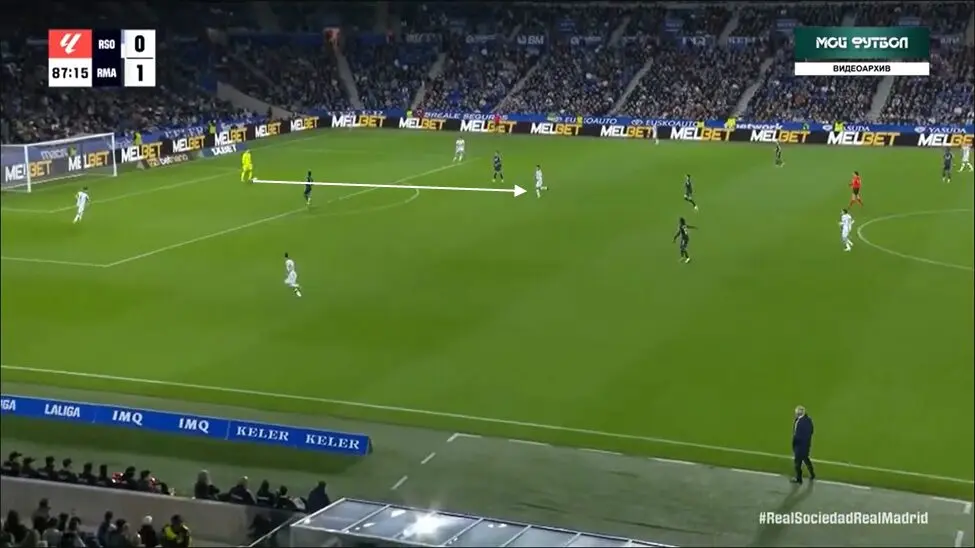
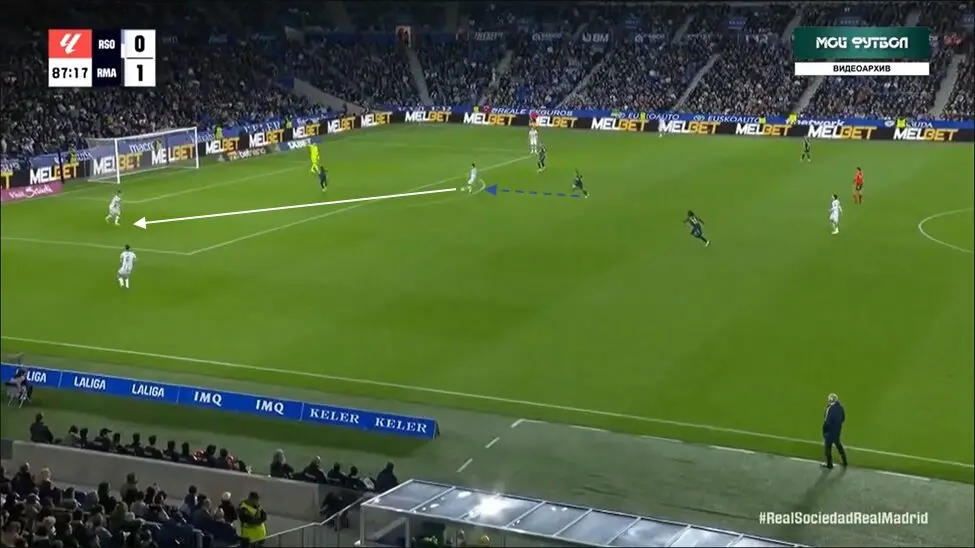
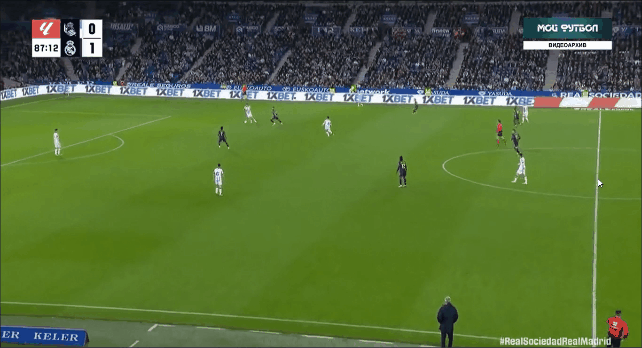
Influencing the Game Without the Ball:
As mentioned earlier, Zubimendi serves as the metronome at the heart of this Sociedad team, thanks to his impeccable timing, quality passing, and constant awareness of his surroundings, which helps him consistently evade pressure. But his influence on the game isn’t just about passing. Interestingly, Zubimendi only ranks in the 62nd percentile for passes attempted—not exactly what you’d expect from a player whose most vital attribute is passing.
Even more surprising, he ranks just in the 57th and 54th percentiles for touches and passes received per game, respectively. So, how can a player who isn’t heavily involved in his team’s sequences with the ball, still be this important?

When Sociedad begins circulating possession and building up play from the back, you’ll often see Zubimendi probing the space in front of the backline, constantly shifting to open up passing lanes for his teammates. But his contribution doesn’t stop there!
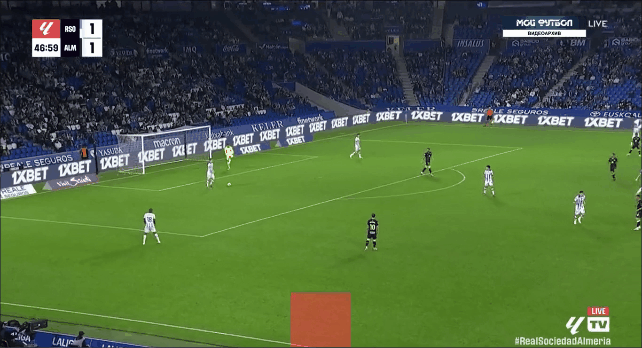
He’s not always demanding the ball, which might explain his low touch numbers—instead, he’s comfortable letting his opponents mark him while he keeps moving, dragging his markers around to create space for his teammates to push the ball forward. Let’s take a look at this example to illustrate the point.
Here, you can see an Alaves player shadow-marking Zubimendi, preventing him from receiving the ball. But instead of forcing himself into becoming a passing option, Zubimendi continues moving in his marker’s shadow, who’s also looking to press the ball carrier at the same time.
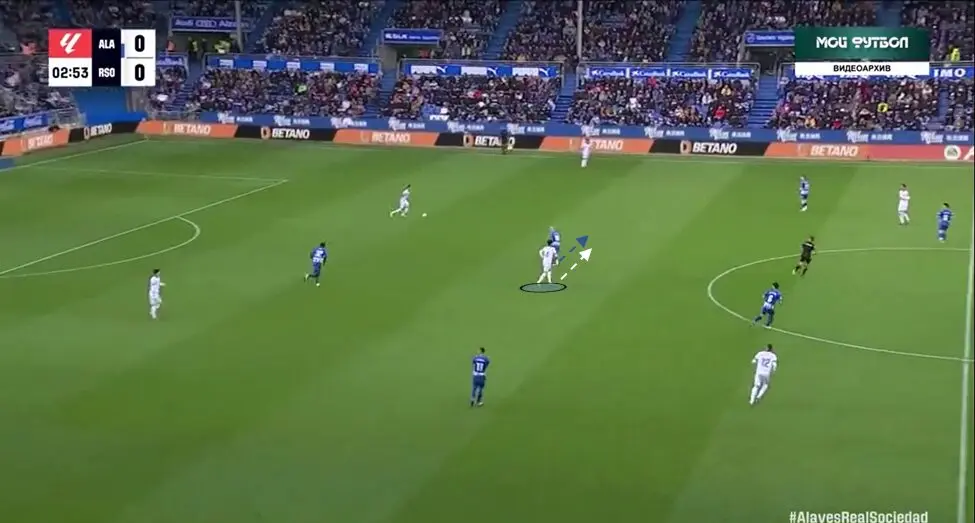
However, instead of continuing his movement, Zubimendi suddenly stops and takes a few steps back. This forces his marker to abandon the pressing run and stick with him instead, giving the ball carrier more time and space on the ball.
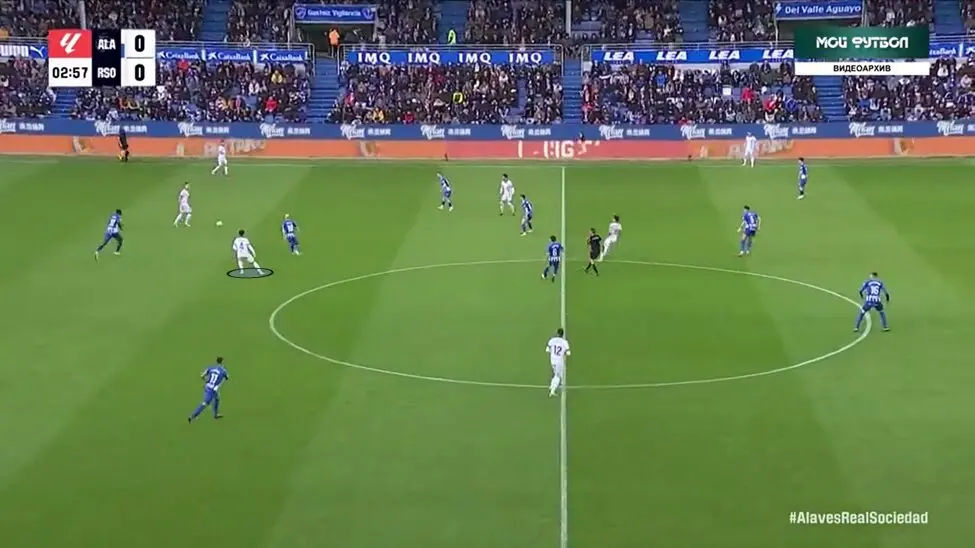
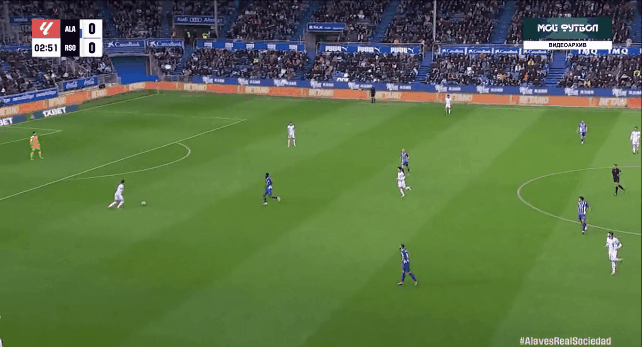
Football is like chess, where every small detail can make a huge difference. Giving your teammates even just an extra second can allow them to maintain possession or advance the ball under better conditions.
This is exactly why Zubimendi isn’t ranked high in touches or passes received—his influence often goes beyond just having the ball at his feet. His intelligent movement and sharp understanding of space are key to his impact, showing why stats alone don’t always tell the full story.
This also explains why Zubimendi’s progressive passing numbers aren’t exceptionally high. Sociedad’s backline is typically responsible for progressing the ball, whether through passing or carrying it forward. And they’re able to do this effectively because Zubimendi’s movement creates the space for them. But that doesn’t mean he’s incapable of progressing the ball himself!
Let’s take a look at another sequence to illustrate this. Here, once again, we see Zubimendi dragging his marker with him, opening up space for the center-back to push forward with the ball.
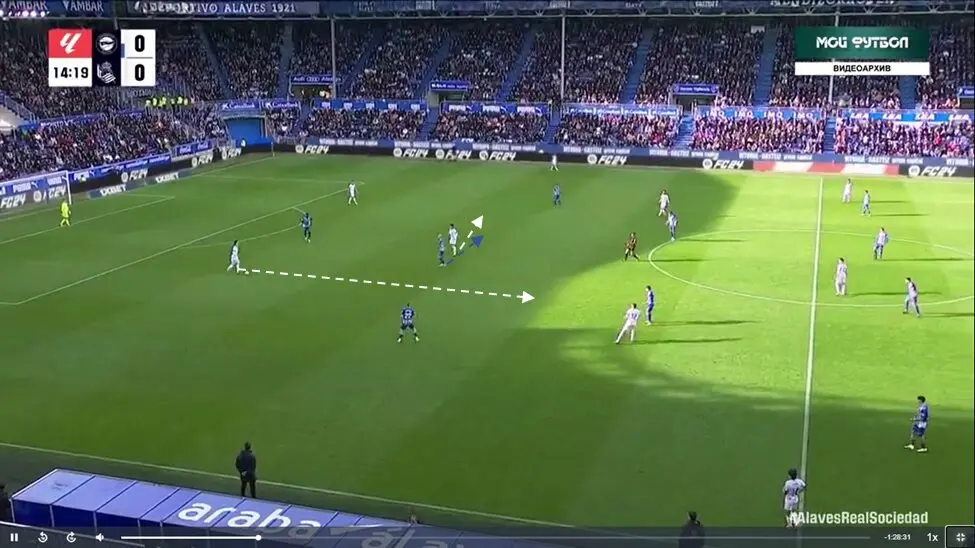
Once the ball was progressed, Zubimendi positioned himself to face the play, ready to receive the ball again. His quick adjustment ensured he was available for the next phase of the buildup, always one step ahead in supporting the team’s possession.
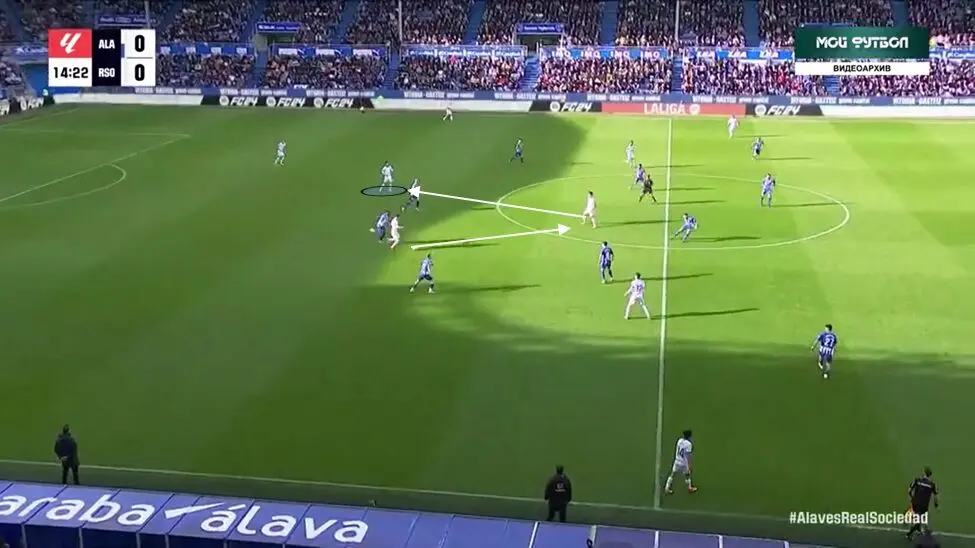
Zubi then proceeds to break the opposition’s lines with a left-footed pass, demonstrating just how comfortable he is playing with both feet.
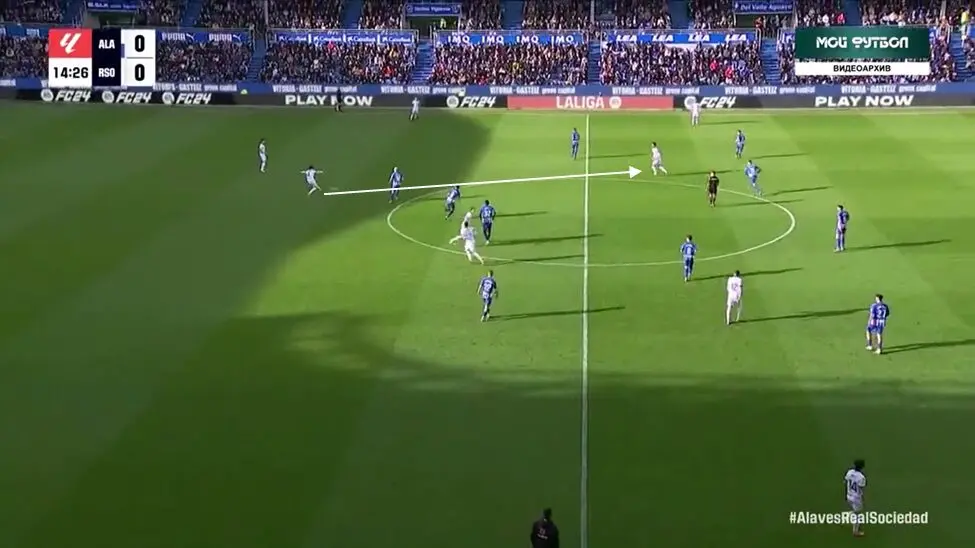
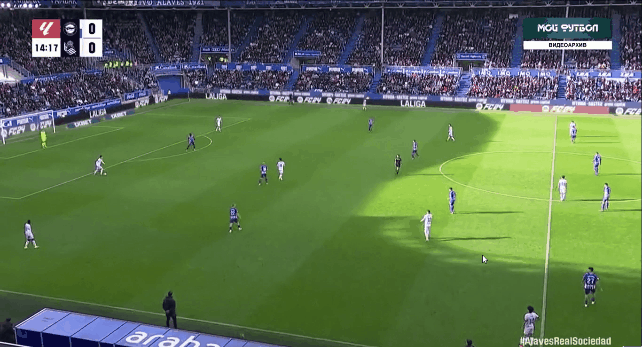
See, Zubimendi can definitely play progressive passes. It’s more about the team’s playing style or even his own preference. Another proof of this is his high pass completion rate across all ranges of passes. Just because he doesn’t attempt these kinds of passes every time he has the chance doesn’t mean he can’t do it! He simply picks his moments wisely, contributing to the team’s control and stability.
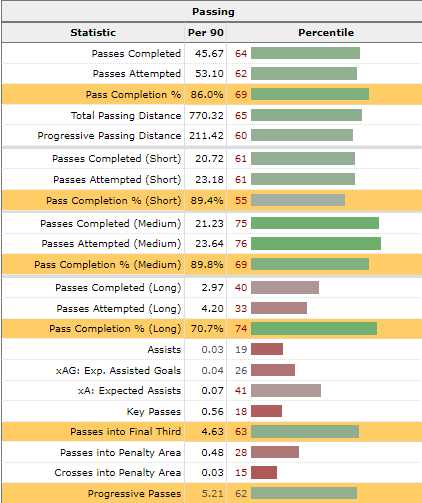
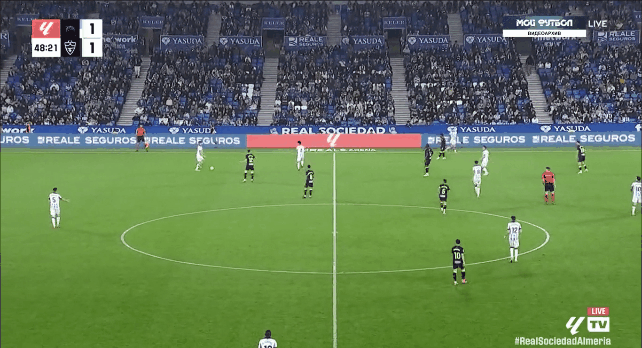
Final Third Impact:
We’ve covered Zubimendi’s attributes in deeper areas, which is where he primarily operates. But that doesn’t mean he can’t make an impact higher up the pitch!
As we’ve mentioned, Zubi is usually the deepest player in the double pivot. However, with his constant movement to create space for others, he often ends up interchanging positions with his pivot partner, essentially becoming more of an “eight.”
His seasonal heatmap from the last campaign shows that he was active all over the pitch, less so in the final third and penalty box.
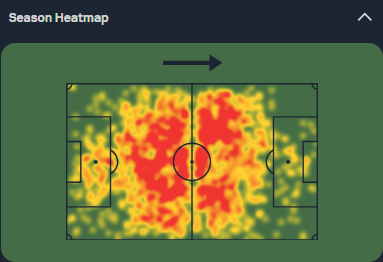
He maintains the same quality and timing in his passing, along with that calm, composed presence. Take this sequence, for example. Here, you can see Zubimendi making an explosive run into the opposition’s central areas, showing his ability to influence the game further up the field.
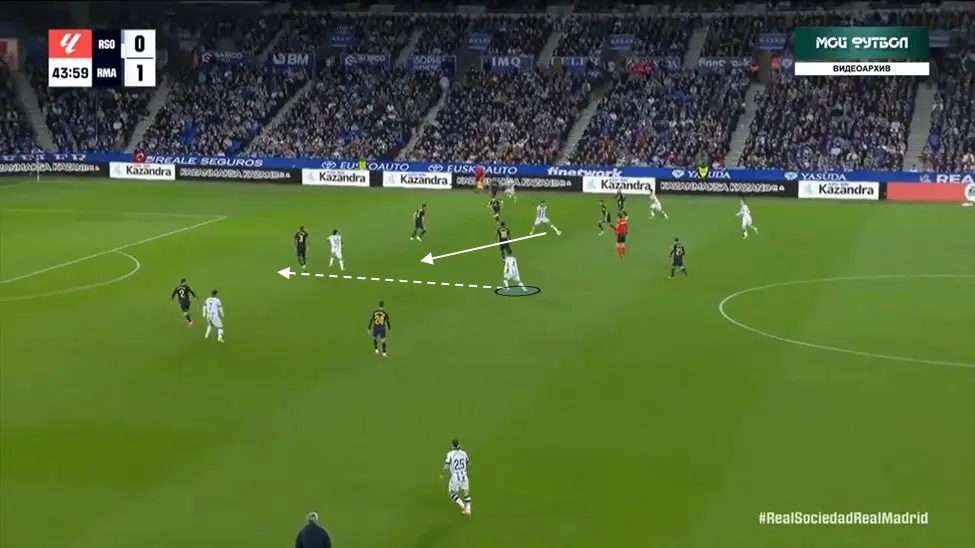
Upon receiving the ball, Zubi’s instinct, as always, is to pass it immediately—and that’s exactly what he did, slipping a well-timed pass through to his teammate.
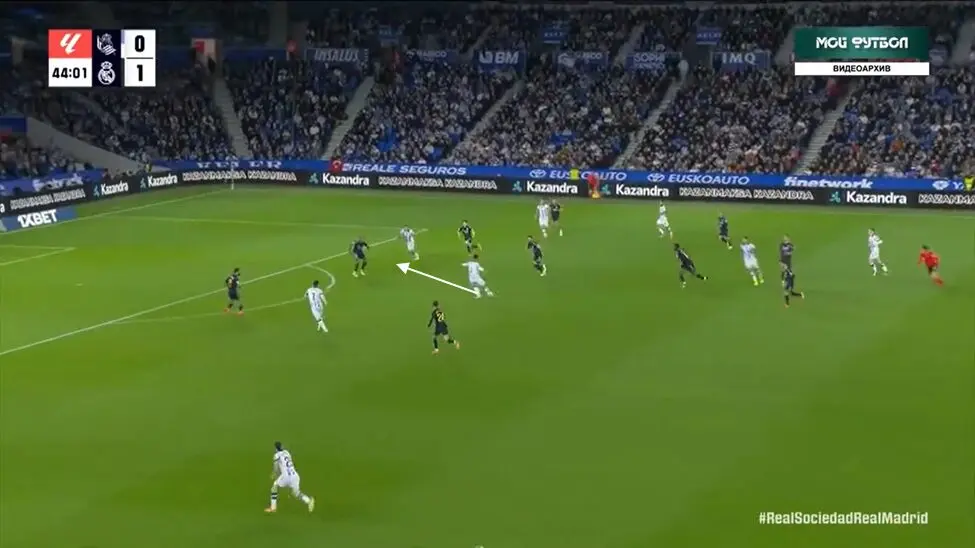
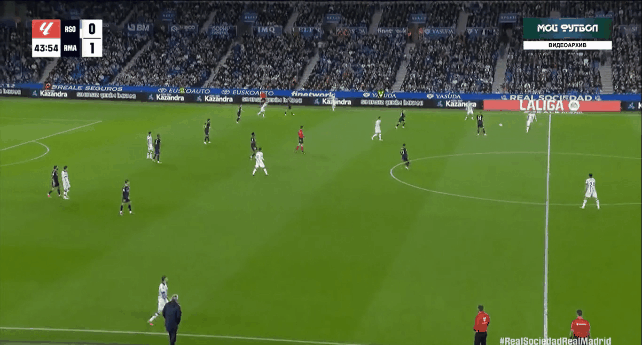
If that wasn’t enough to demonstrate Zubimendi’s influence in the final third, let’s look at his pre-assist against Almeria.
Once again, he advanced higher up the pitch and found himself with the ball in acres of space.
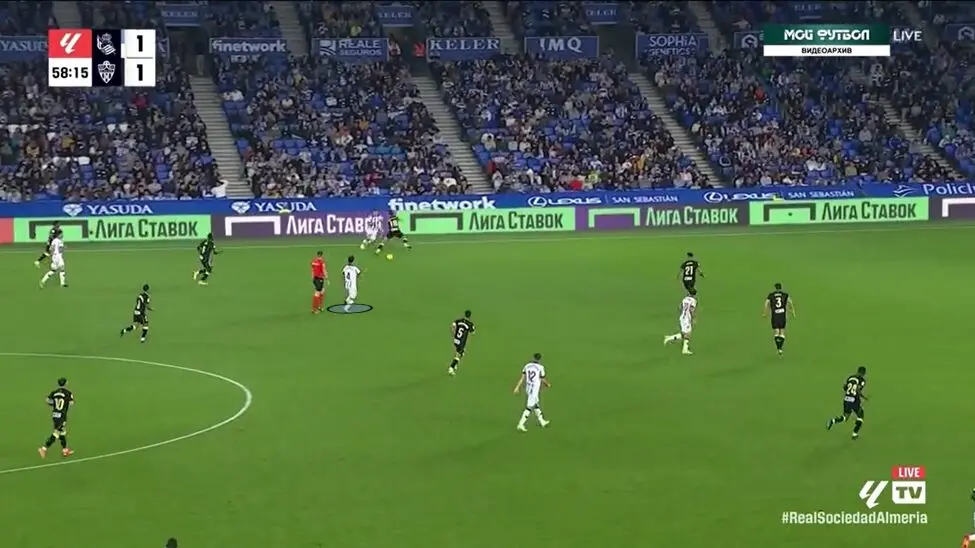
He then proceeded to carry the ball forward, before spotting his teammate on the right hand side and unleashing a beauty of a switch, setting the player to grab the assist for the second goal.
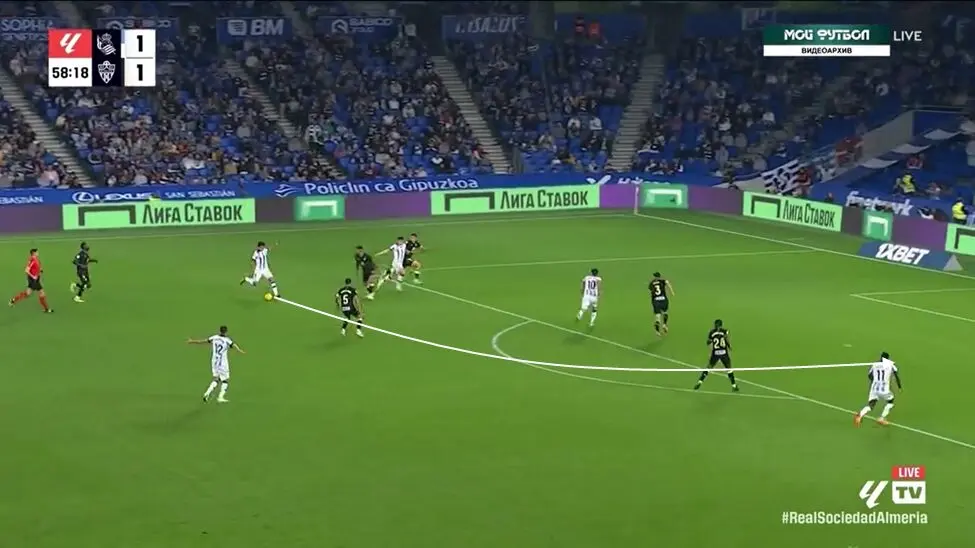
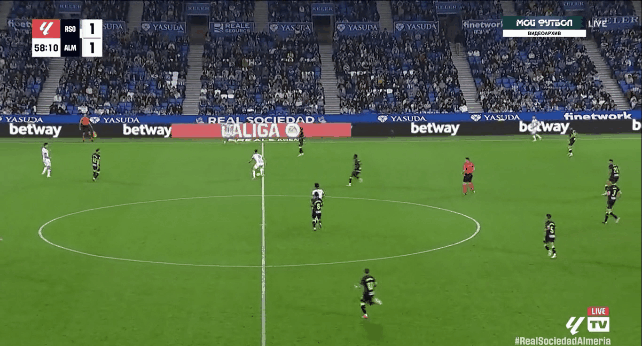
In fact, Zubimendi’s final third contribution was at it’s peak last season as he had his best goalscoring campaign, netting four of the eight goals he’s scored in his career. This uptick was largely due to how often he began making runs into the final third and around the box, using his excellent spatial awareness to position himself in dangerous, goal-scoring areas.
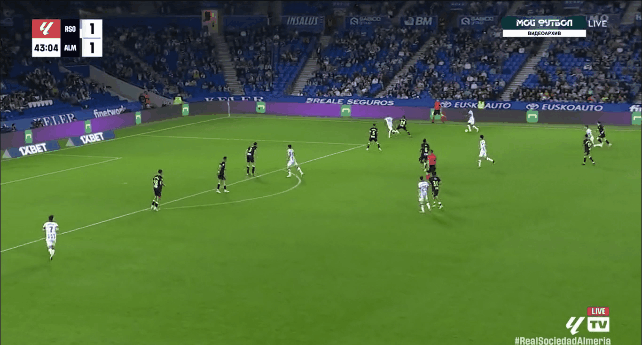
And just like his passing, Zubi’s shooting is also accurate, averaging 41.4 percent shots on target, which is quite impressive compared to other defensive midfielders.
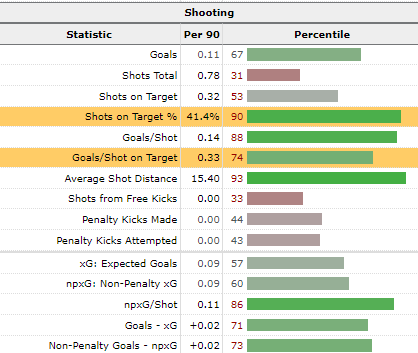
He is simply efficient in front of the goal despite not always being that high up the pitch. In fact, his ranking as the 10th midfielder for goal conversion rate is perhaps the best proof of his ability to find the net.
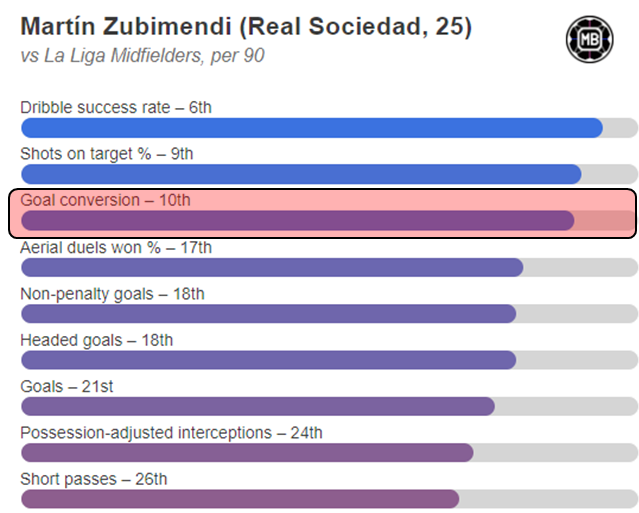
Out of Possession:
Already Used to How “Elite” Sides Play?
So far, we’ve explored Zubimendi’s in-possession skills, his vital role in the build-up phase, and how he can be a game-changer higher up the pitch. Now, let’s flip to the other side of the game: his abilities without the ball.
Some might question how Zubimendi would adapt to an intense pressing system and that sets up in a high defensive line. Two aspects of the game that are now attributed to “Elite” teams.
To get a clearer picture, we need to examine certain aspects of Sociedad’s out-of-possession approach.
Surprisingly, Sociedad were one of the most aggressive, pressing teams in Europe’s top five leagues last season. They averaged the fewest passes per defensive action (PPDA), with just 7.56, even lower than Liverpool’s 7.74. Remember, the lower the PPDA, the more intense the pressing!
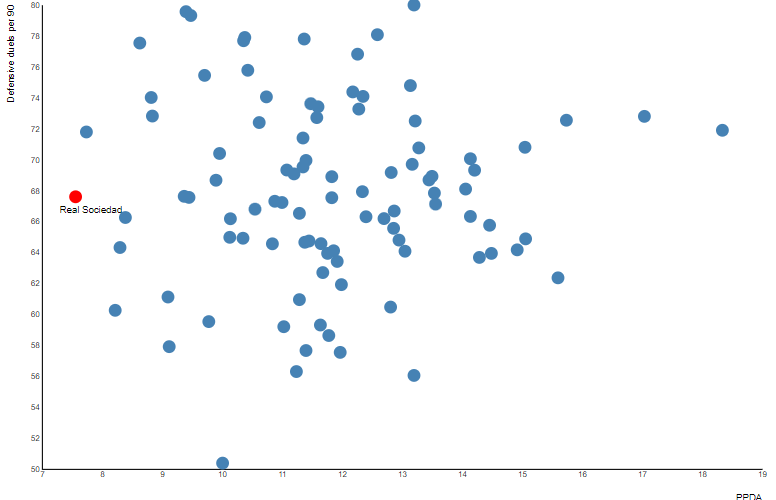
Additionally, Real Sociedad averaged the second-highest defensive line in La Liga, with a line of 49.28 meters. To put that into perspective, this would place them third in the Premier League, behind only Manchester City and Arsenal, and ahead of Liverpool. This shows that Zubimendi is already used to operating in a high-line system, which could ease his adaptation to a top Premier League club if a deal ever materializes.

This clearly indicates that Zubimendi is already accustomed to playing in such a system. However, we still need to examine how he’s utilized out of possession.
In this sequence, you can see how high Sociedad pressed, applying intense pressure that forced the opposition to go long. Interestingly, notice that Zubimendi isn’t joining the press.

In fact, Zubimendi was tasked with guarding the space in central areas, ensuring the team remained balanced. He wasn’t required to push aggressively to intercept long passes, either. Instead, it was often the defenders who stepped up higher to intercept those plays, allowing Zubimendi to hold his position and maintain control in the midfield.

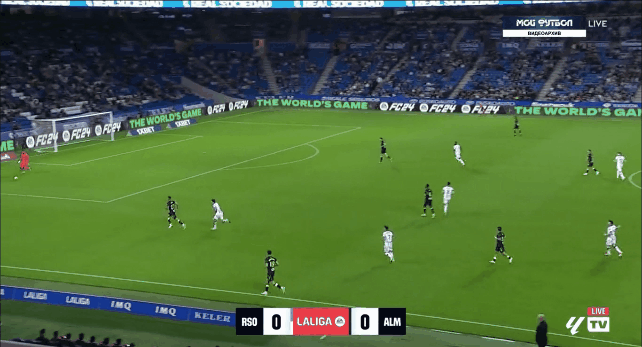
He’s given that role so that once possession is won back, he’ll be the first player to receive the ball and begin circulating it, initiating another build-up phase.
You can see the same approach when Zubimendi occasionally pushes higher to join the press—his backline provides cover behind him, pushing up to maintain a compact shape and prevent the opposition from exploiting the space left in midfield.
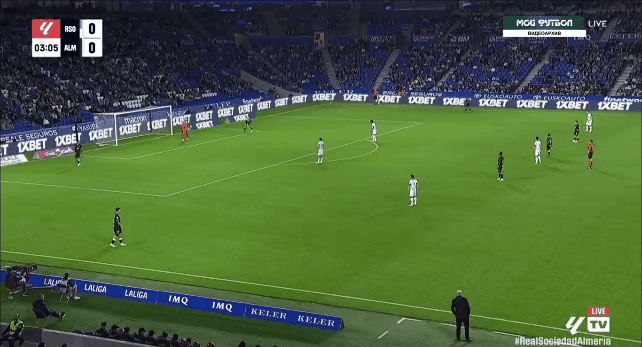
A Calculated Number Six
Zubimendi isn’t required to be overly aggressive in his role; instead, it’s the backline that takes care of most of the “dirty work” for him. But does that mean he can’t defend? Absolutely not!
In his 45-minute appearance against England, Zubimendi won all five of his ground duels. Last season, his tackling success rate was equally impressive, ranking in the 78th percentile for the percentage of dribblers tackled, with a success rate of 53.8%.
But here’s the twist: it’s the frequency of his tackles that might catch some attention. He averaged just 1.79 tackles per 90 minutes, which isn’t particularly high for your typical holding midfielder.
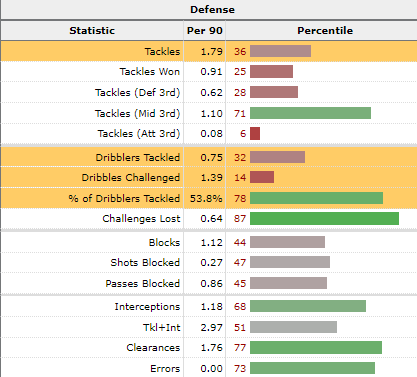
This low tackling volume is largely due to the role he’s assigned out of possession, with the backline handling much of the ball-winning duties. But it also reflects Zubimendi’s preferred style of defending.
The Spaniard isn’t the type to constantly engage in defensive duels or aggressively chase down opponents. Instead, he focuses on defending space, cutting off passing lanes, and positioning himself to block the opposition’s path by jockeying them sideways. His approach is more about control and intelligence than sheer aggression.
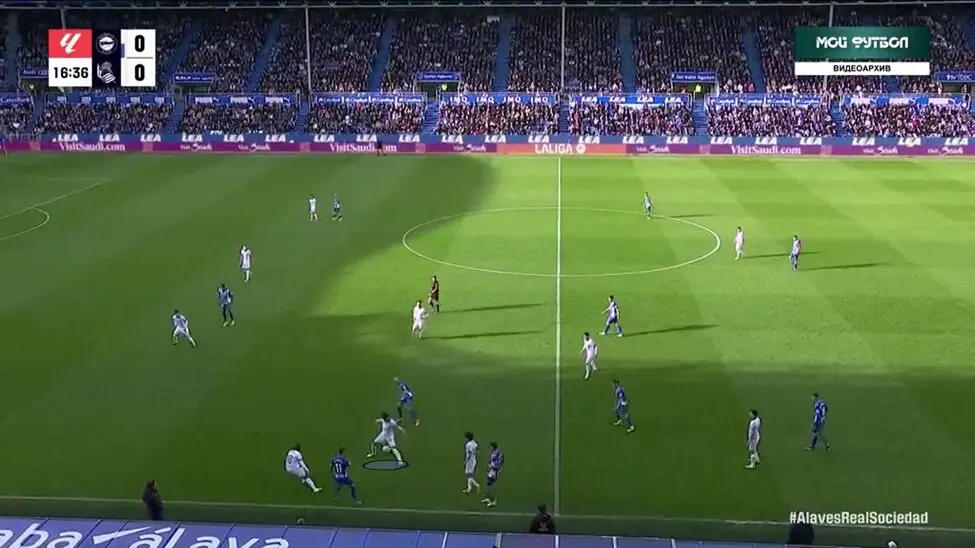
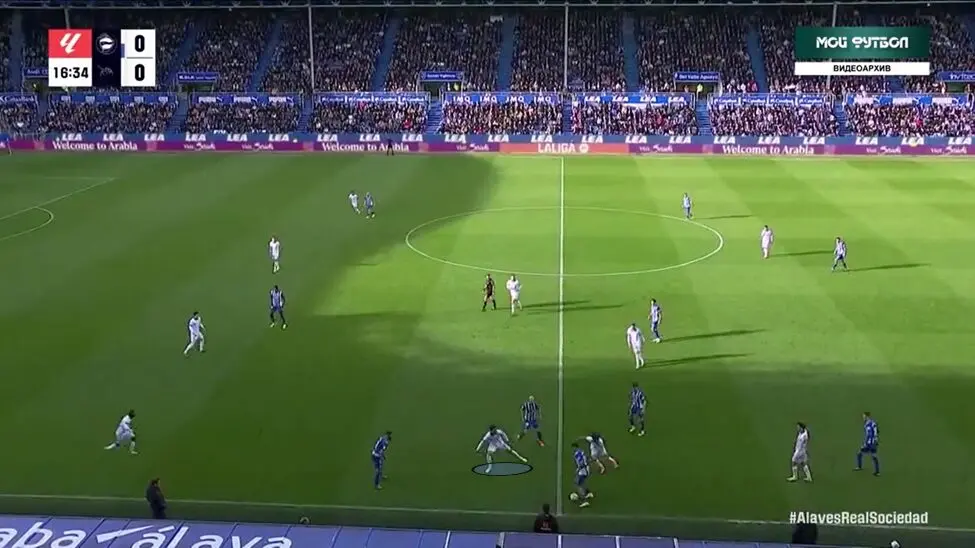
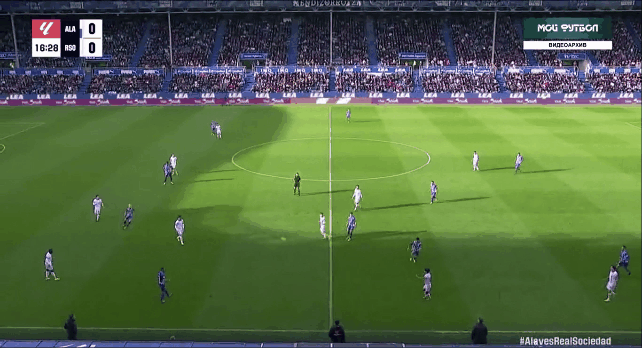
Zubimendi’s excellent positioning allows him to consistently cut off available passing lanes, forcing opponents to play sideways or backward instead of advancing. This gives his teammates valuable time to regroup and get back into shape, ensuring the team remains defensively organized and difficult to break down.
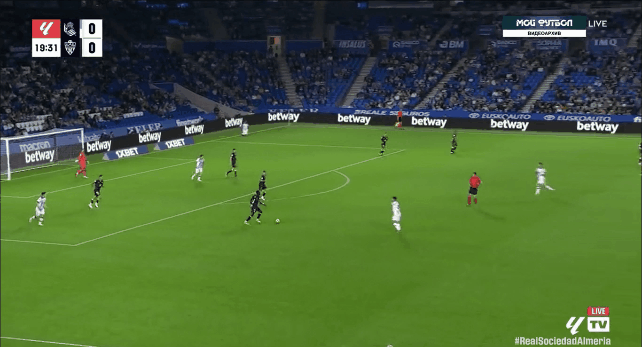
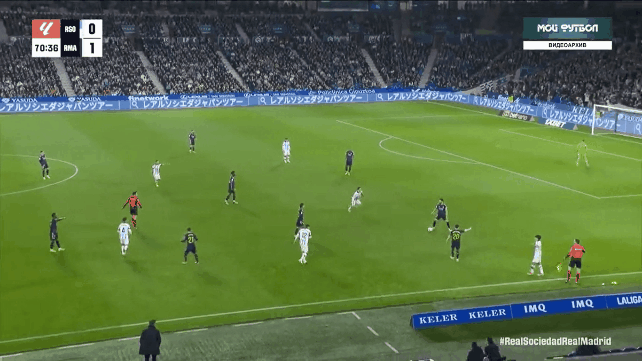
Again, Zubimendi’s low tackling numbers don’t suggest he’s a poor defender. Rather, they reflect his preference to defend space and cut off passing options instead of diving into challenges. However, when he does go in for a tackle, it’s clear that he knows how to dispossess opponents effectively.
This is highlighted by a plot chart of midfielders from Europe’s top five leagues, where Zubimendi ranks in the lower half for the number of defensive duels but is among the top performers in terms of winning percentage. This shows that while he may not engage often, when he does, he’s highly efficient.
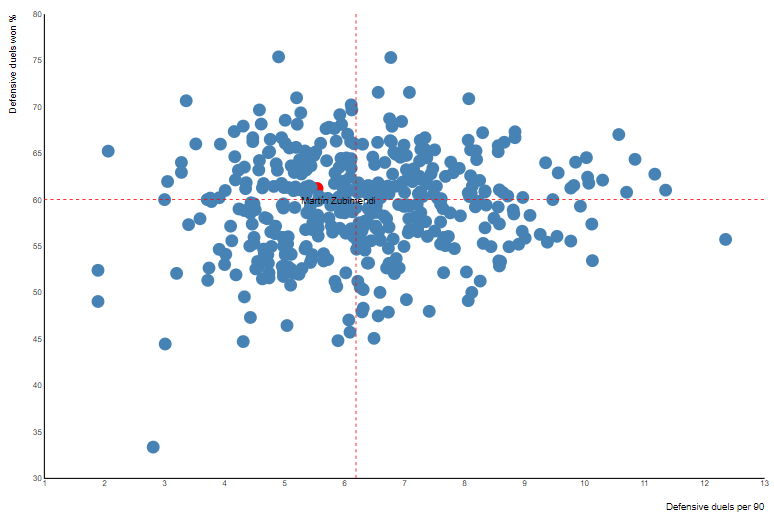
Once Zubimendi commits to a tackle, he’s like a tick—quick and relentless. He slips his legs in just at the right moment to either push the ball away or steal it cleanly, making it difficult for opponents to shake him off once he’s engaged.
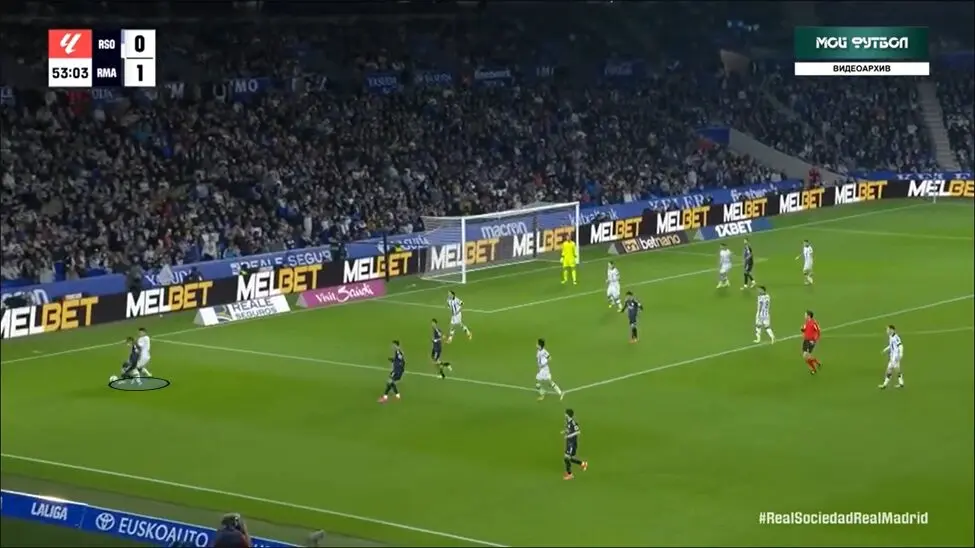
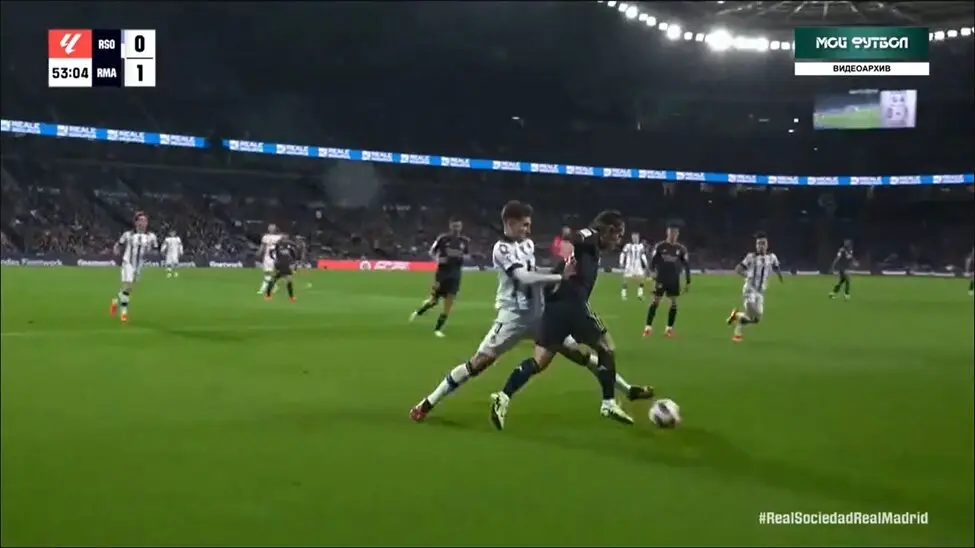
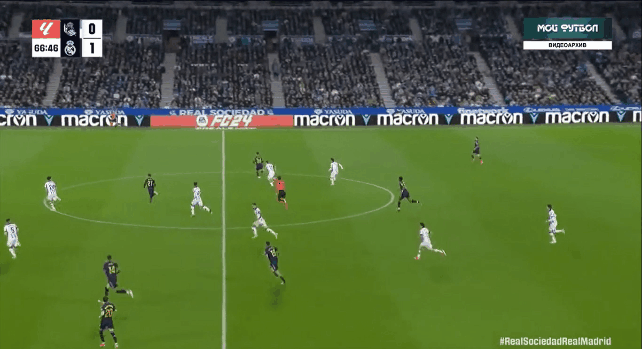
Zubimendi’s reluctance to engage in tackles shouldn’t be mistaken for hesitation or cowardice; it’s all about composure and sticking to his plan of defending space to disrupt the opposition’s play, all while picking the right moments to commit in his tackling.
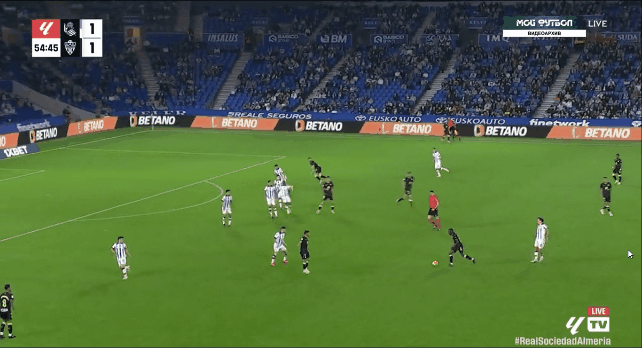
Another attribute that needs to be highlighted is the player’s aerial ability despite being just 5ft11. Last season, he averaged 61.1 percent aerials won per 90 minutes, putting him in the 90th percentile amongst La Liga midfielders. This season is no different, with him averaging 68 percent after nine league games.
Just like his defending on the ground, Zubimendi’s timing and positioning, alongside his impressive vertical leap, allow him to win most of his duels.
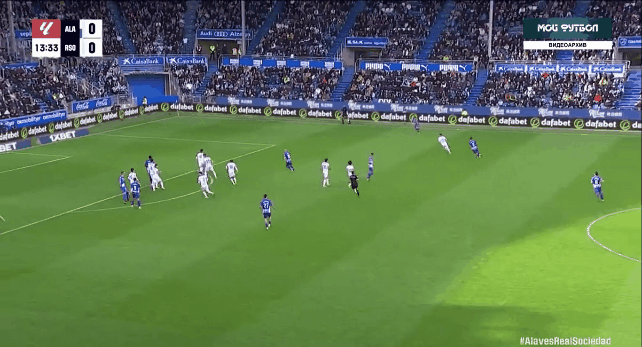
Now, there are two key questions about his out-of-possession abilities. First, can he cover space during transitions? His positional discipline and spatial awareness will definitely help in these situations. But what about his mobility?
It’s true that Zubimendi isn’t the fastest player, but he’s far from slow. Take this particular moment when Real Madrid launched a counterattack from the edge of their own area—notice how high up the pitch Zubimendi was.
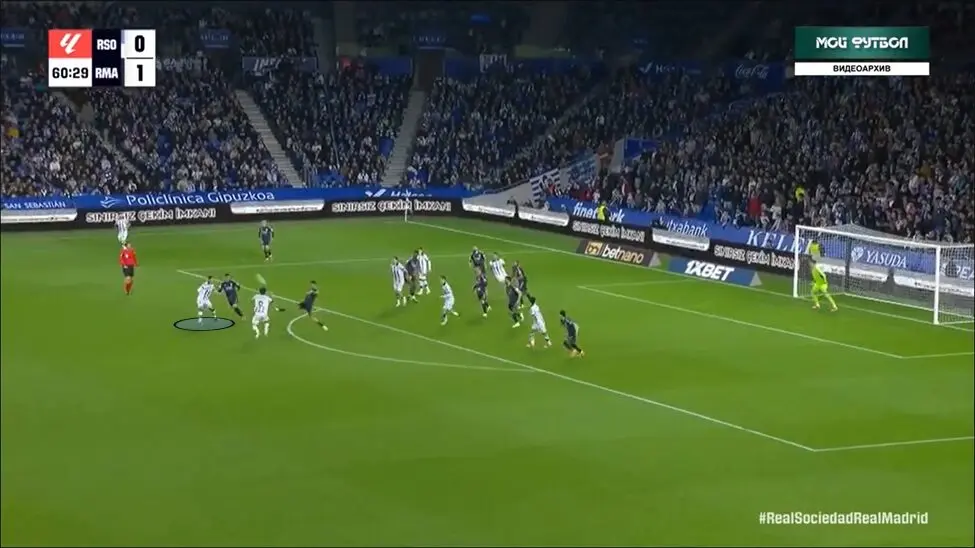
However, it only took him six seconds to get back into position, helping his side slow down Madrid’s transition.
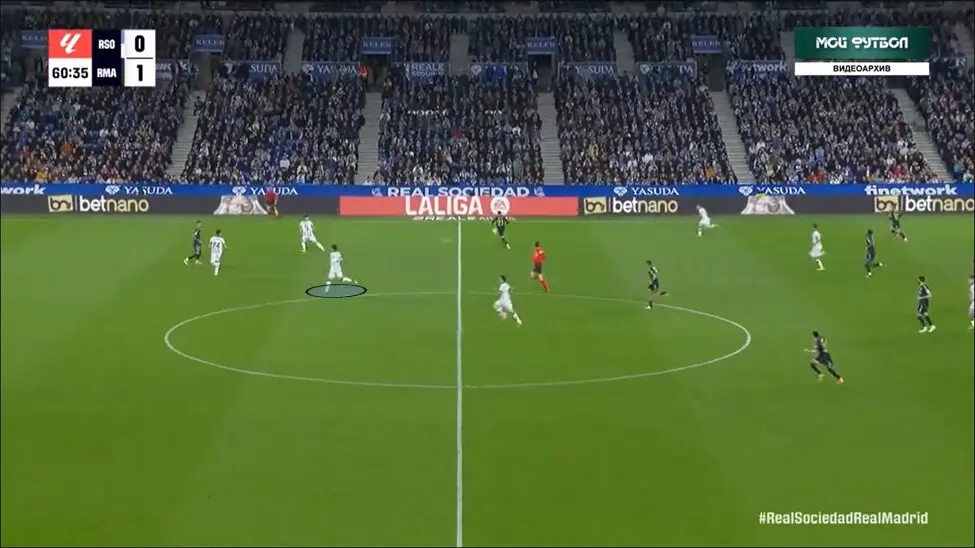
It’s also important to note that Zubimendi’s recovery abilities extend beyond just counterattacks. He’s equally adept at responding when his teammates misplace passes. In this instance, an awkward pass was played, and the opposition immediately pressed Zubimendi to force a high turnover. Still the player was capable of adjusting his body and reaching the ball first.
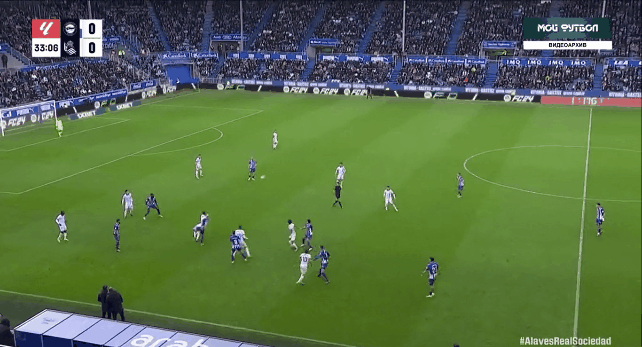
However, one concern arises when Zubimendi occasionally becomes too focused on tracking his man, which can pull him out of position. While we’ve emphasized his strong positional discipline, there are moments where he gets drawn out of his zone by the opposition—ironically, the same tactic he uses to unsettle defenders when Sociedad is in possession, as we discussed earlier. This is an area where he could improve to ensure he maintains better balance defensively.
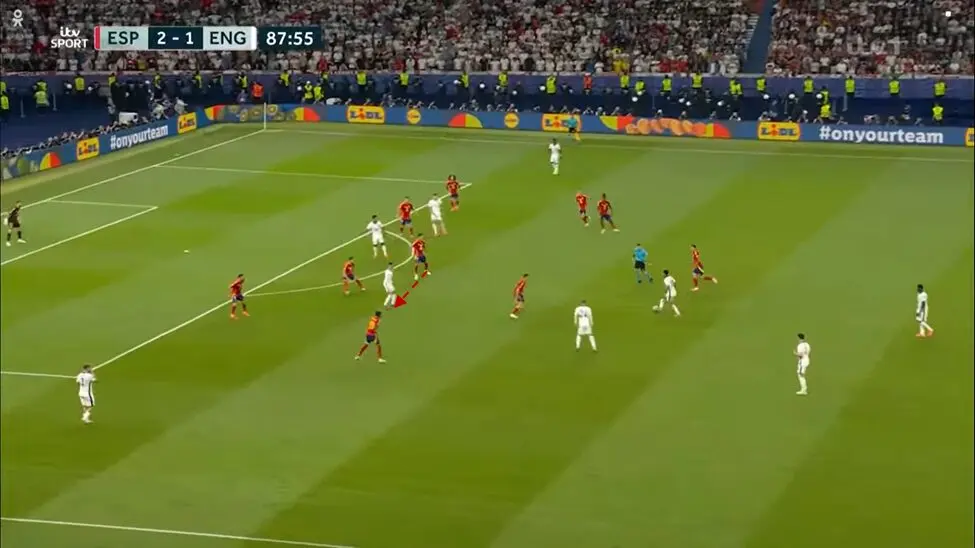
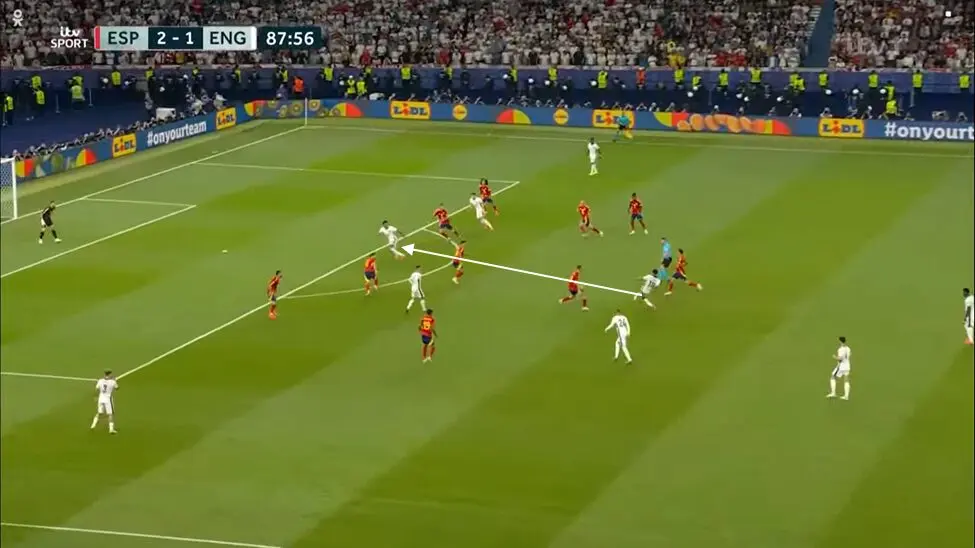
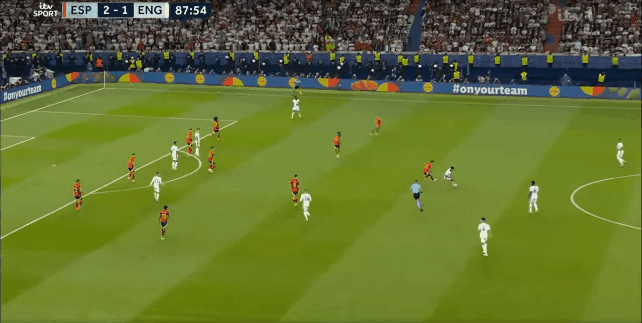
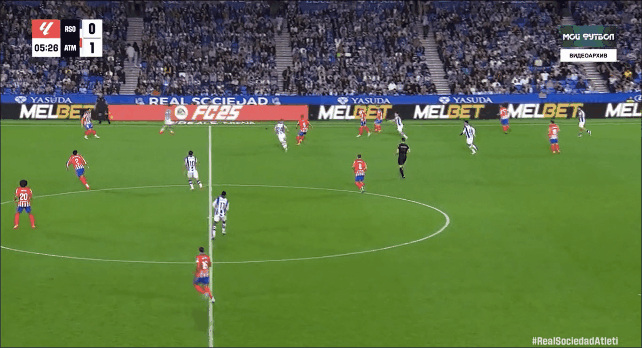
Why Liverpool Wanted Him:
Now that we covered the player’s abilities, it became clear why he’s currently the most wanted number six in the world. It also becomes clearer why Liverpool were eager to secure his signature last summer.
Arne Slot often uses a 4-2 or 4-1 build-up shape. While Liverpool’s back four isn’t as flat as Sociedad’s—since their fullbacks tend to occupy narrower spaces—the way the double pivots line up in staggered lines is something Zubimendi is already familiar with, as we discussed earlier. This tactical overlap could make his integration into Liverpool’s system much smoother.
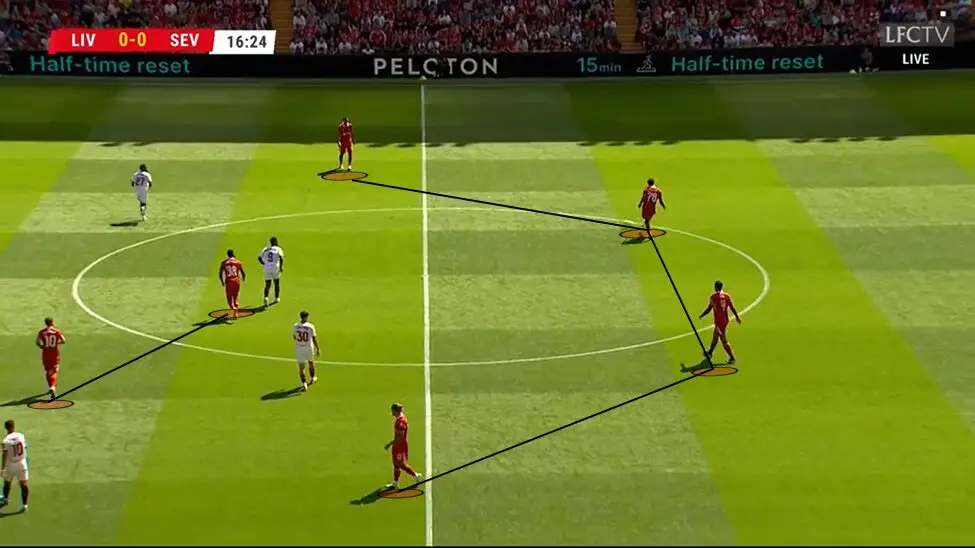
The Reds currently lack a first-phase receiver of Zubimendi’s caliber. Wataru Endo isn’t as comfortable in possession, and we’ve seen Mac Allister struggle when tasked with being the first station for ball progression from deep. That’s why Gravenberch was paired with the Argentine so far this season, and while the Dutchman ca undoubtedly be considered as one of the Reds’ best players so far, he still lacks in some areas that can take Liverpool’s build-up phase up another level.
It’s Zubimendi’s simplicity in recycling possession, combined with his spatial awareness, that makes him a unique profile compared to what Liverpool currently has. He would be the “metronome” Liverpool need as his ability to time passes perfectly and constantly create space for his teammates would be crucial to the way Arne Slot wants to build from the back, especially when baiting the opposition’s press.
And when spaces open up behind enemy lines, Zubimendi has the ability to break through them with precise passes, helping the Reds transition seamlessly from the first phase of build-up to the second, and even into the final third.
Taking his Game Up To Another Level
This season, with the departures of Mikel Merino and Robin Le Normand, Zubimendi seems to be taking matters into his own hands, already racking up better numbers than last season.
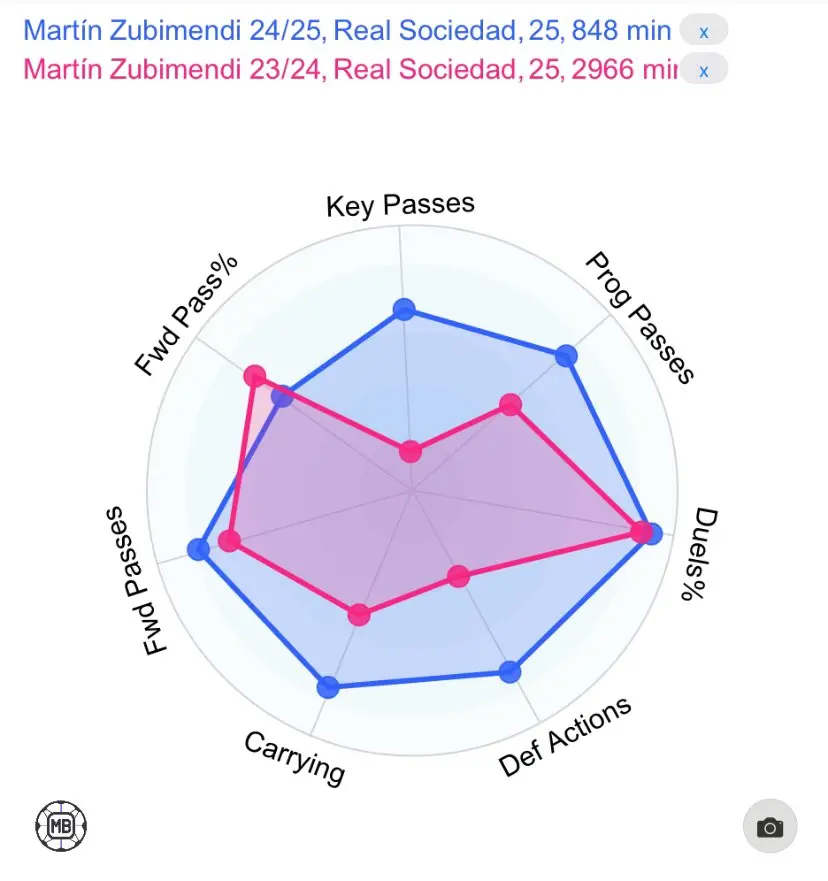
The 25-year-old still operates as Real Sociedad’s deeper midfielder in their 4-2 or 4-1 build-up shape. His role is basically the same as last season: control the tempo, distribute the ball and help maintain possession.
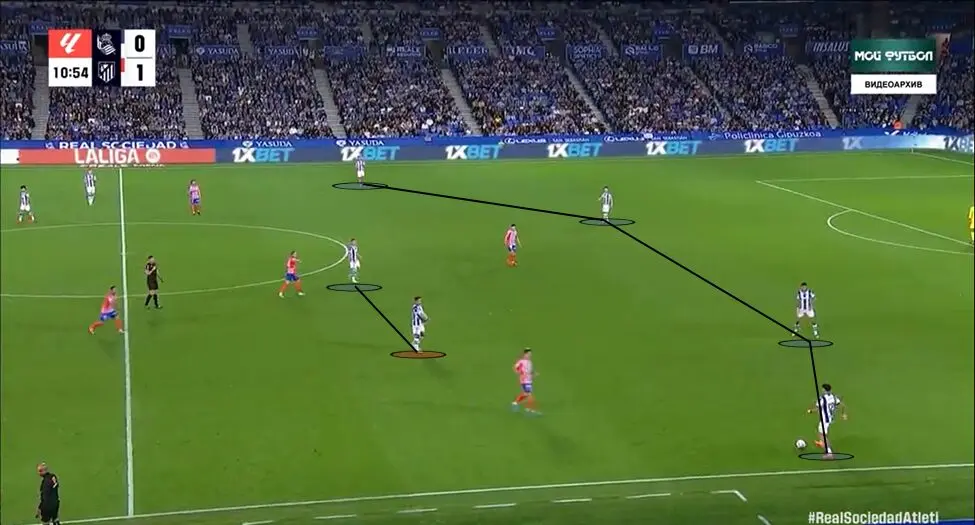
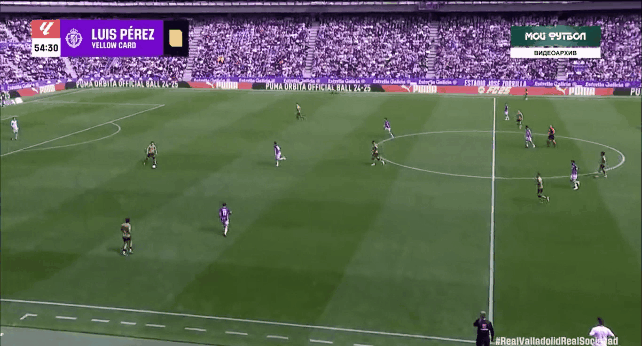
However, two aspects of his game seem to be different, whether by his choice or a managerial decision. The first is his aggressiveness without the ball. Although Zubimendi still has “average” defensive duels per 90, his individual numbers have increased compared to last season, all while maintaining his high duel-winning percentage.
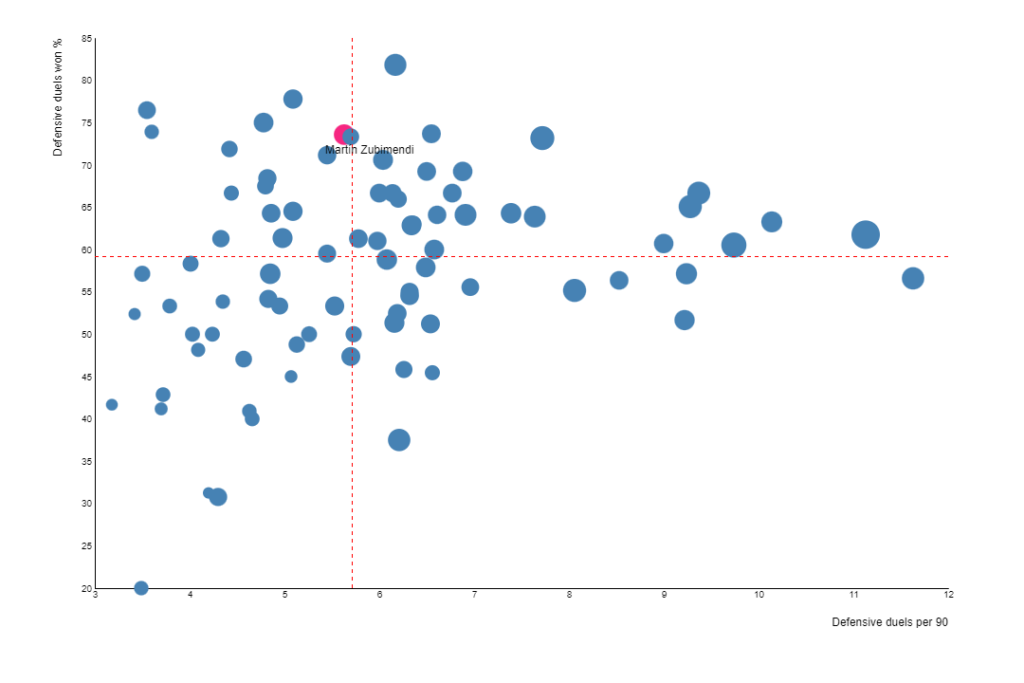
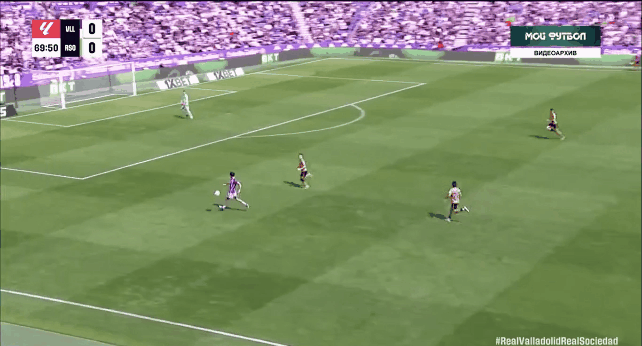
Zubimendi looks to have added a bit more aggressiveness to his defending approach, no longer limiting himself to cutting lanes and shadow-marking his opponents. This is evident in his 2.47 tackles per 90 this season compared to 1.79 in the last.
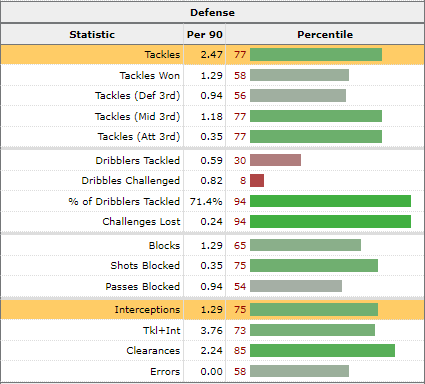
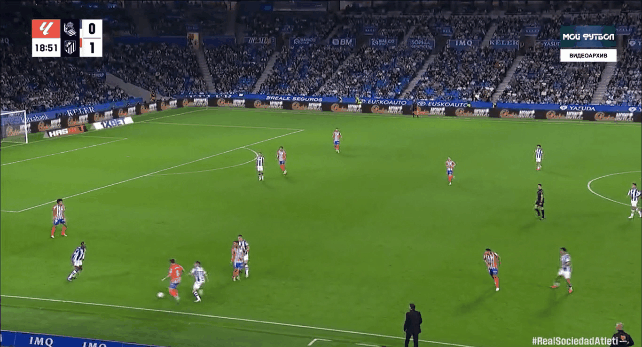
The second aspect of Zubimendi’s game that’s now becoming more visible is his progressiveness. As mentioned earlier, he has the ability to break opposition lines with his progressive passes and carrying, but due to Real Sociedad’s preference for using their backline to drive the ball forward, Zubimendi’s numbers in this area were below average. This season, however, things are starting to look different.
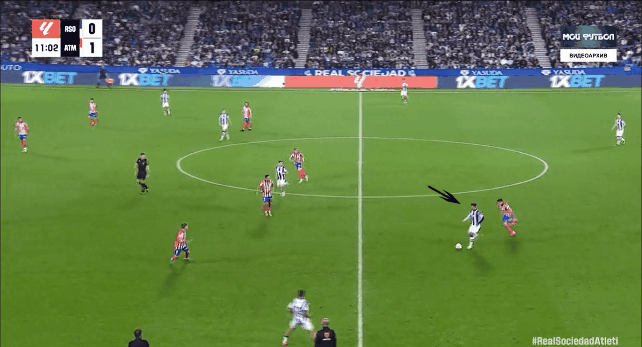
The player is getting more on the ball, averaging 74.12 touches per game, putting him in the 82nd percentile amongst other La Liga midfielders. He’s also averaging more passes, but more importantly, more progressive passes as he currently ranks in the 87th percentile in this metric in the 89 percent of players for passes into the final third.
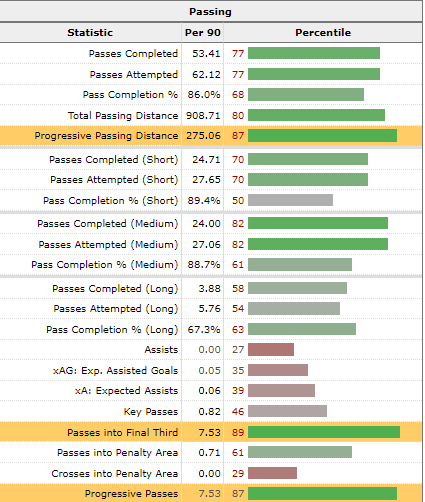
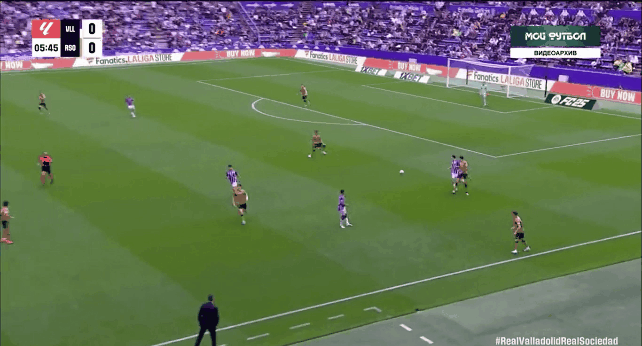
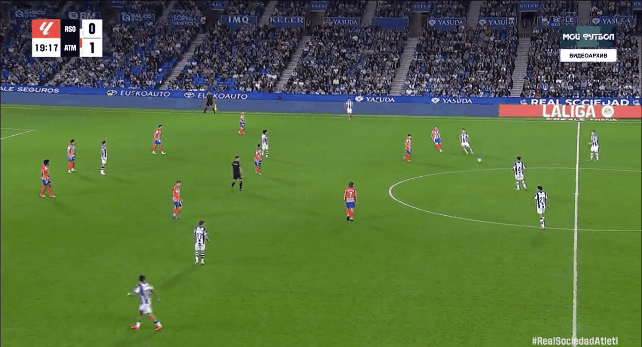
This shift may be due to the fact that Zubimendi now finds himself at the heart of the “up, back, and through” pattern that Real Sociedad is using more frequently this season. The backline initiates the sequence with a direct ball to the wingers or forwards, who then set the ball back to Zubimendi. In that moment, he becomes the player responsible for delivering the “through” pass to move the play forward.
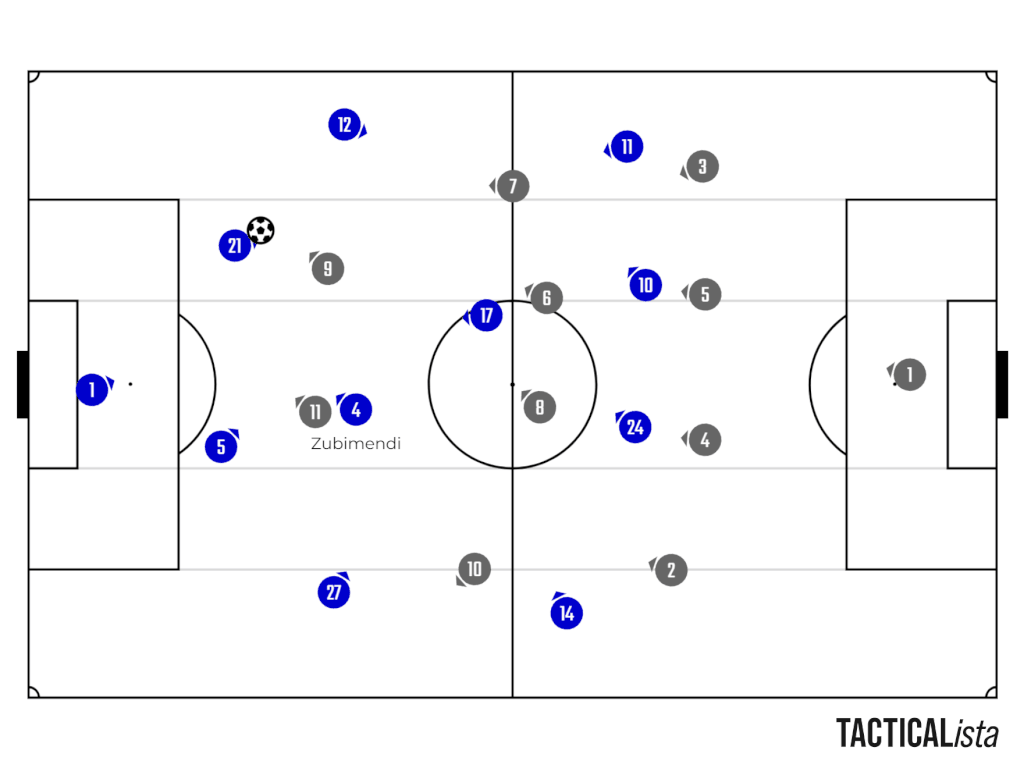
The increase in Zubimendi’s numbers didn’t come out of nowhere. His technical ability has always been evident, whether in a Real Sociedad shirt or with the Spanish national team. His “average” numbers from last season—particularly in tackling intensity and ball progression—weren’t due to any lack of skill, but rather a reflection of his calculated approach both with and without the ball.
Whether Zubimendi will make the jump to a top team in the future remains to be seen, given his loyalty and affection for his boyhood club. However, it’s safe to say that he would undoubtedly improve any team he joins, whether that’s Arne Slot’s Liverpool, Guardiola’s Rodri-less City or even Real Madrid.


